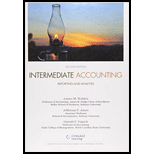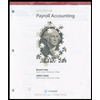
1.
Calculate the average remaining service life of Company T for 2016.
1.
Explanation of Solution
Pension plan: Pension plan is the plan devised by corporations to pay the employees an income after their retirement, in the form of pension.
Calculate the average remaining service life of Company T for 2016 as follows:
Working note (1):
Calculate the total service years rendered.
| Employee numbers | Expected years of future service | Service years rendered |
| 1-5 | 3 | 15 |
| 6-10 | 6 | 30 |
| 11-15 | 9 | 45 |
| 16-20 | 12 | 60 |
| 21-25 | 15 | 75 |
| 26-30 | 18 | 90 |
| 31-35 | 21 | 105 |
| 36-40 | 24 | 120 |
| Total service years rendered | 540 | |
Table (1)
2.
Prepare a schedule to calculate the net gain or loss component of pension expense of Company T during 2016 and 2017.
2.
Explanation of Solution
Prepare a schedule to calculate the net gain or loss component of pension expense of Company T during 2016 and 2017 as follows:
| Year |
Cumulative net loss (gain) (A) |
Corridor (B) |
Excess net loss (gain) | Amortized net loss (gain) |
| 2016 | $29,000 | $47,000 (2) | - | - |
| 2017 | $29,000 | $68,600 (3) | - | - |
Table (2)
Working note (2):
Calculate the amount of corridor for 2016.
Working note (3):
Calculate the amount of corridor for 2017.
Note: The projected benefit obligation of both 2016 and 2017 is more than the fair value of plan asset. Hence, the amount of corridor is calculated from 10% of the projected benefit obligation.
The cumulative net loss of 2016 and 2017 does not exceed corridor, therefore no amortized net loss incurred during 2016 and 2017.
3.
Prepare a schedule to calculate the pension expense of Company T for 2016 and 2017.
3.
Explanation of Solution
Prepare a schedule to calculate the pension expense of Company T for 2016 and 2017 as follows:
| Particulars | Amount in ($) | Amount in ($) |
| Service cost | 169,000 | 175,000 |
| Add: Interest cost on projected benefit obligation | 47,000 (4) | 68,600 (5) |
| Less: Expected return on plan assets | (40,500) | (62,050) |
| Pension expenses | $175,500 | $181,550 |
Table (3)
Working note (4):
Calculate the interest cost on projected benefit obligation for 2016:
Working note (5):
Calculate the interest cost on projected benefit obligation for 2017:
4.
Prepare necessary journal entries of Company T for 2016 and 2017.
4.
Explanation of Solution
Prepare
In this case, Company T has underfunded the pension contribution by $500
| Date | Accounts Title and Explanation | Post Ref. | Debit ($) | Credit ($) |
| December 31,2017 | Pension expense | 175,500 | ||
| Cash | 175,000 | |||
| Accrued/prepaid pension cost | 500 | |||
| (To record the underfunded pension expense of $500) |
Table (4)
- Pension expense is component of shareholders’ equity, and it decreases the value of shareholders equity. Hence, debit the pension expense with $175,500.
- Cash is an asset account and it is decreased. Therefore, credit the cash account with $175,000.
- Accrued/prepaid pension cost is liability account and it is increased. Therefore, credit the accrued/prepaid pension cost account with $500.
Note: For accrued/prepaid pension cost no other adjustment is required. Because there are no amortization of the cumulative net loss, and the balance of $65,500
Prepare journal entry to record the pension expense for 2017:
In this case, Company T has underfunded the pension contribution by $3,550
| Date | Accounts Title and Explanation | Post Ref. | Debit ($) | Credit ($) |
| December 31,2017 | Pension expense | 181,550 | ||
| Cash | 178,000 | |||
| Accrued/prepaid pension cost | 3,550 | |||
| (To record the underfunded pension expense of $3,550) |
Table (5)
- Pension expense is component of shareholders’ equity, and it decreases the value of shareholders equity. Hence, debit the pension expense with $181,550.
- Cash is an asset account and it is decreased. Therefore, credit the cash account with $178,000.
- Accrued/prepaid pension cost is liability account and it is increased. Therefore, credit the accrued/prepaid pension cost account with $3,550.
5.
Calculate the total accrued/prepaid pension cost of Company T at the end of the 2016, and explain whether it is considered as an asset or a liability.
5.
Explanation of Solution
Calculate the total accrued/prepaid pension cost of Company T at the end of the 2016, and explain whether it is considered as an asset or a liability as follows:
| Accrued/prepaid pension cost | |||
| Beg. Bal. | $65,000 | ||
| December 31, 2016 | $500 | ||
| Total | $65,500 | ||
| Clos. Bal. | $65,500 | ||
In this case, the accrued/prepaid pension cost account at the end of 2016 shows a credit balance, hence it is considered as the accrued pension cost liability ($65,500).
Want to see more full solutions like this?
Chapter 19 Solutions
Intermediate Accounting: Reporting and Analysis (Looseleaf)
 Intermediate Accounting: Reporting And AnalysisAccountingISBN:9781337788281Author:James M. Wahlen, Jefferson P. Jones, Donald PagachPublisher:Cengage Learning
Intermediate Accounting: Reporting And AnalysisAccountingISBN:9781337788281Author:James M. Wahlen, Jefferson P. Jones, Donald PagachPublisher:Cengage Learning
 Individual Income TaxesAccountingISBN:9780357109731Author:HoffmanPublisher:CENGAGE LEARNING - CONSIGNMENT
Individual Income TaxesAccountingISBN:9780357109731Author:HoffmanPublisher:CENGAGE LEARNING - CONSIGNMENT




